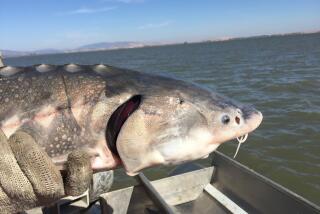In Deep Water : Report Says White Croaker Has Been Contaminated by Oil Products
- Share via
Pity the poor white croaker.
The unfortunate fish’s flesh is marinated in DDT derivatives, PCBs and other toxic chlorinated hydrocarbons.
The state says not to eat it. Its population appears to be dwindling. And to add insult to injury, a new report says the livers of white croakers caught in some South Bay waters not only contain those toxics but also are soaked in derivatives of crankcase oil, gasoline, kerosene and other petroleum products. As a result, the croakers are getting liver cancer, the report said.
“Basically, there is a serious problem,” said Dr. Donald C. Malins, who directed the research for the report. “When we looked at the bile we found the highest concentrations of these hydrocarbon derivatives in any fish we have examined.”
The contamination discovered by Malins’ team of six researchers is generated by the automobile and affects every urban harbor in the United States, according to the scientist.
The Los Angeles area, which accounts for 6% of the hydrocarbons entering coastal waters throughout the world, is particularly hard hit, he said.
“Hydrocarbons are a major threat to aquatic life,” Malins said.
None of that matters to Dwayne Powdrill, 34, a Compton resident who fished away a blue-sky afternoon the other day on the pier off the Cabrillo Beach breakwater in San Pedro.
“I look at it this way,” Powdrill declared, displaying a bucket full of white croakers. “People got to eat. You catch something. You skin it. You fry it. Why should you pay attention to anyone when you are hungry? You got to eat.”
So, too, must the white croaker.
One of Malins’ main conclusions is that the white croaker’s diet--sea worms, crustaceans and clams--is unhealthy because of contamination in sea-bottom sediment.
“The most significant aspect is, not only are these compounds getting into the environment but they are getting into the fish” through their diet, Malins said.
He chose the white croaker for research because it appears along much of the California coast, is a common sport fish, is sold commercially for food and is representative of other bottom-feeding species.
The work of his team appears in the current issue of the scientific journal Environmental Science and Technology and was sponsored by the National Oceanic and Atmospheric Administration, where he was director of the Environmental Conservation Division of the Northwest and Alaska Fisheries Center. Malins is head of the environmental biochemistry program for the Pacific Northwest Research Foundation.
In 1984 and 1985, his group examined the bile, stomach contents and livers of white croakers caught in the Cerritos Channel in Los Angeles Harbor, off Terminal Island’s Reservation Point and in Queensway Bay off Long Beach. They also studied fish caught near sewage-plant outfalls off White Point in San Pedro and off the Hyperion plant near El Segundo.
White croakers from less developed Dana Point, just north of San Clemente, were used as a reference point. They showed far lower levels of toxic chemicals than the fish caught in Los Angeles waters, and far fewer of their livers were cancerous.
While Malins’ work confirmed earlier research showing high levels of DDT derivatives and PCBs--both of which cause cancer--in white croakers, his findings deal with compounds known as “aromatic hydrocarbons,” which come from petroleum products.
Dr. Gerald A. Pollock, staff toxicologist for the state Department of Health Services, said Malins’ research underscores the department’s 1985 warning--based on the discovery of DDT and PCB contamination--not to eat white croakers. He said follow-up work is needed to evaluate the possible health effect on humans of fish contaminated with aromatic hydrocarbons.
Explaining the origin of the contaminants, Malins said, “The major contributors to hydrocarbons in urban environments are commercial parking lots, highways, streets--in other words, the automobile. It is almost certain that this is the major problem in Los Angeles.”
“There is almost no control about the dumping of oil and greases. . . . It amounts to many tons of hydrocarbons every year. We now know from this study that they are not just sitting there inertly. . . . We are beginning to see signs of cancer in the white croaker and related diseases of the liver.”
The worst areas for aromatic hydrocarbons were Cerritos Channel and Queensway Bay, which receive less tidal flushing than more open waters.
The compounds were 75 times more concentrated in fish caught in Cerritos Channel than in fish caught off Dana Point, and sediment from the channel and Dana Point also showed a dramatic difference in concentration of hydrocarbons. About one quarter of the Cerritos Channel fish had signs of liver cancer, but none from Dana Point did.
The most disturbing aspect of the work, however, was the fish they didn’t find, Malins said.
“The vessels would go out time and time again and come back with only one fish or none at all,” Malins said. “Either the National Oceanic and Atmospheric Administration doesn’t know how to fish--and I don’t believe that to be the case--or there are very few fish to be obtained . . .
“It is possible that many of these important species of fish have been depleted to the point that we are looking at residual populations, which have been contaminated and are diseased. . . . Some of these environments are so toxic that it is amazing that there are any fish remaining today.”
On the San Pedro fishing pier, Los Angeles resident Kay Hayward, 71, had caught one of the elusive white croakers. Unlike Powdrill, she said she was not going to eat it.
“I’m going to put it in my rose garden,” she said. “I’ll cover it up so the cats can’t dig it up.”
More to Read
Sign up for Essential California
The most important California stories and recommendations in your inbox every morning.
You may occasionally receive promotional content from the Los Angeles Times.










